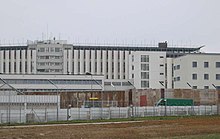Big crisis team
The Great Crisis Team (GKS, also Great Location ) and the Small Location were two crisis teams set up by the Federal Government on September 6, 1977 immediately after the kidnapping of Hanns-Martin Schleyer by the Red Army Faction (RAF) . The establishment was a consequence of the escalating terror of the RAF during the German autumn , the effects of which were interpreted as an emergency situation. In other emergency situations, too, the federal government convenes crisis teams, which the press sometimes refer to as the “large crisis team”. This article deals with the crisis teams generally known under this name from 1977, which, uniquely in the history of the Federal Republic of Germany , coordinated the actions of federal and state governments, the law enforcement authorities and the parliamentary groups. Various authors rated the situation at the time as a non-declared state of emergency .
Crisis teams

Small location
The "Kleine Lage" (called "Little Crisis Team" by the media) met several times a day with Federal Chancellor Helmut Schmidt and his advisors, Federal Interior Minister Werner Maihofer , Justice Minister Hans-Jochen Vogel , Foreign Minister Hans-Dietrich Genscher (partly represented by Federal Economics Minister Otto Graf Lambsdorff ), State Minister Hans-Jürgen Wischnewski , Head of the Chancellery Manfred Schüler , Government Spokesman Klaus Bölling , BKA President Horst Herold and Attorney General Kurt Rebmann .
Big crisis team
The “Big Crisis Team” (initially called “Big Political Advisory Group”), which met once or twice a week (initially more often), included the members of the “Small Situation”: Willy Brandt , Helmut Kohl , Franz Josef Strauss , Herbert Wehner , Wolfgang Mischnick , Friedrich Zimmermann , and the four Prime Ministers of the states in whose custody RAF prisoners were: Hans Filbinger (Baden-Württemberg), Alfons Goppel (Bavaria), Heinz Kühn (North Rhine-Westphalia), Hans-Ulrich Klose (Hamburg). Joachim Zahn , Chairman of Daimler-Benz AG, was also involved in some of the meetings .
Working method
The two crisis teams are neither provided for in the Basic Law , nor was there a legal basis. The crisis team therefore had no decision-making authority in the legal sense either. He could only act through the ministries and authorities represented in him. Legislative procedures had to take the (fundamental) legal route, even if there was consensus in the crisis team.
The main effect of the crisis teams was therefore to shorten the decision-making time through intensive coordination between all parties involved.
Resulting situation and resolutions
Comprehensive manhunt
A comprehensive manhunt was initiated. For example, radio data stations were set up at important motorway junctions, via which all passing drivers between the ages of around 20 and 35 were queried via Inpol . The BKA requested copies of contracts from all passenger cars bought in the Federal Republic of Germany . In Cologne , a start was made to check all electricity customers for their police reports.
Contact lock
Since September 6, 1977, shortly after the kidnapping began, contact was blocked for imprisoned terrorists of the Red Army Faction with reference to the justifying state of emergency under Section 34 of the Criminal Code (StGB) . The contact block was implemented immediately, the contact block law only passed the Bundestag days later and was countersigned by the Federal President on October 1, 1977 . The law came into effect the following day. The Contact Blocking Act was the fastest law passed in the history of the Federal Republic of Germany up to that day (3 days). On September 23, the 3rd Senate of the BGH approved the previously implemented ban on contacts. The Federal Constitutional Court declared on October 4, the contact ban law to be constitutional.
Message lock
A news blackout was "imposed" by the GKS, which was reported to the media on September 8, 1977. The newspapers and broadcasters voluntarily adhered to this lockdown and did not print messages sent directly to them by kidnappers . The foreign press criticized this decision and continued to report on the current status of the kidnapping .
Code of Criminal Procedure
In addition, the Code of Criminal Procedure was changed so that a defendant may name a maximum of three lawyers in one criminal proceeding . Andreas Baader and other defendants of the RAF or their splinter groups had previously been represented by up to 15 defenders at the same time. Both laws were applied to the arrested RAF terrorists in October 1977.
literature
- Wolfgang Kraushaar : “The state of emergency that has not been declared” in “The RAF and left-wing terrorism”, Hamburger Edition HIS Verlag, Hamburg 2007.
- Ulf G. Stuberger : “In the criminal case against Andreas Baader, Ulrike Meinhof, Jan-Carl Raspe, Gudrun Ensslin for murder and the like. a. - Documents from the process “, Europäische Verlagsanstalt, Hamburg 2007, ISBN 978-3-434-50607-2
- * A German autumn. Conditions 1977. By Tatjana Botzat , Elisabeth Kiderlen and Frank Wolff . ISBN 3-8015-0315-1
- Stefan Aust : " The Baader Meinhof Complex ", exp. u. update A., Goldmann, Munich 1998, ISBN 3-442-12953-2
- Peter Graf Kielmansegg : After the catastrophe - A history of divided Germany , Siedler Verlag, Berlin 2000, ISBN 3-88680-329-5 , p. 338ff.
Web links
- http://www.stern.de/politik/historie/:Terrorismus-RAF-Schmidt-Genscher-Visier/596891.html?eid=501091
- http://www.burks.de/forum/phpBB2/viewtopic.php?t=2425
- http://www.sueddeutsche.de/politik/raf-terrorismus-tage-im-herbst-1.801525
Individual evidence
- ^ Butz Peters : 1977 - RAF against Federal Republic , Munich 2017, ISBN 978-3-426-27678-5
